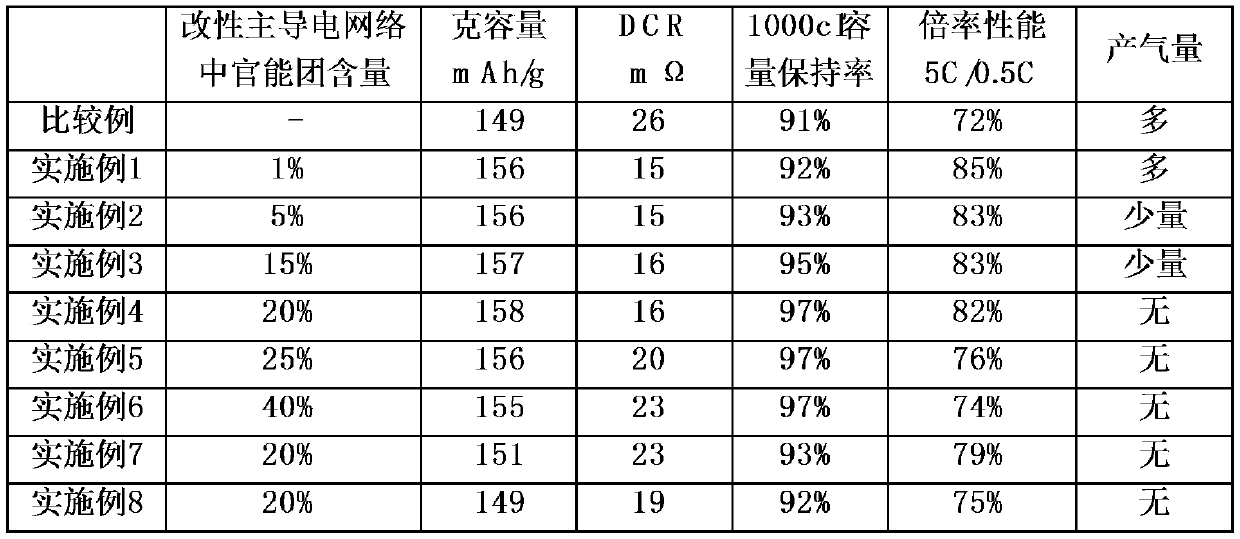Lithium titanate negative electrode material and preparation method thereof
A negative electrode material, lithium titanate technology, applied in nanotechnology for materials and surface science, battery electrodes, nanotechnology, etc., can solve the problems that affect the electrochemical performance of lithium titanate negative electrode materials, large contact resistance, battery internal resistance Advanced problems, to achieve the effect of solving gas production problems, ensuring stability, and low impedance
- Summary
- Abstract
- Description
- Claims
- Application Information
AI Technical Summary
Problems solved by technology
Method used
Image
Examples
Embodiment 1
[0041] Embodiment 1 is different from the comparative example in that this embodiment comprises the following steps:
[0042] Step 1, precursor preparation: lithium titanate, methyl methacrylate, sodium dodecyl sulfate (mass ratio is lithium titanate: methyl methacrylate: sodium dodecyl sulfate = 95:4:1) and NMP after mixing (solid content is 10%) and kneading, the revolution is 30 rev / min, and the autorotation is 300 rev / min; kneading for 4h obtains a uniformly dispersed precursor;
[0043] Step 2, preparation of the main conductive network structure of modified worm-like graphene: selecting microcrystalline graphite as a raw material, then adding concentrated sulfuric acid and potassium permanganate for oxidation intercalation to obtain graphite oxide, and then heat-treating to obtain worm-like graphene; The graphene is placed in a mixture of concentrated sulfuric acid, potassium permanganate and sodium nitrate to modify it to obtain a modified worm-shaped graphene grafted w...
Embodiment 2
[0048] Embodiment 2 is different from Embodiment 1 in that this embodiment includes the following steps:
[0049] Step 2, preparation of the main conductive network structure of modified worm-like graphene: selecting microcrystalline graphite as a raw material, then adding concentrated sulfuric acid and potassium permanganate for oxidation intercalation to obtain graphite oxide, and then heat-treating to obtain worm-like graphene; Graphene is placed in a mixture of concentrated sulfuric acid, potassium permanganate, and sodium nitrate to modify it to obtain a modified worm-like graphene grafted with 5% functional groups for use;
[0050] The rest are the same as those in Embodiment 1, and will not be repeated here.
Embodiment 3
[0051] Embodiment 3 is different from Embodiment 1 in that this embodiment includes the following steps:
[0052] Step 2, preparation of the main conductive network structure of modified worm-like graphene: selecting microcrystalline graphite as a raw material, then adding concentrated sulfuric acid and potassium permanganate for oxidation intercalation to obtain graphite oxide, and then heat-treating to obtain worm-like graphene; The graphene is placed in a mixture of concentrated sulfuric acid, potassium permanganate and sodium nitrate to modify it to obtain a modified worm-shaped graphene grafted with 15% functional groups for use;
[0053] The rest are the same as those in Embodiment 1, and will not be repeated here.
PUM
| Property | Measurement | Unit |
|---|---|---|
| diameter | aaaaa | aaaaa |
| particle diameter | aaaaa | aaaaa |
Abstract
Description
Claims
Application Information
 Login to View More
Login to View More - R&D
- Intellectual Property
- Life Sciences
- Materials
- Tech Scout
- Unparalleled Data Quality
- Higher Quality Content
- 60% Fewer Hallucinations
Browse by: Latest US Patents, China's latest patents, Technical Efficacy Thesaurus, Application Domain, Technology Topic, Popular Technical Reports.
© 2025 PatSnap. All rights reserved.Legal|Privacy policy|Modern Slavery Act Transparency Statement|Sitemap|About US| Contact US: help@patsnap.com

